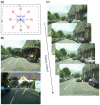Hazard detection with a monocular bioptic telescope
- PMID: 26303448
- PMCID: PMC4589163
- DOI: 10.1111/opo.12232
Hazard detection with a monocular bioptic telescope
Abstract
Purpose: The safety of bioptic telescopes for driving remains controversial. The ring scotoma, an area to the telescope eye due to the telescope magnification, has been the main cause of concern. This study evaluates whether bioptic users can use the fellow eye to detect in hazards driving videos that fall in the ring scotoma area.
Methods: Twelve visually impaired bioptic users watched a series of driving hazard perception training videos and responded as soon as they detected a hazard while reading aloud letters presented on the screen. The letters were placed such that when reading them through the telescope the hazard fell in the ring scotoma area. Four conditions were tested: no bioptic and no reading, reading without bioptic, reading with a bioptic that did not occlude the fellow eye (non-occluding bioptic), and reading with a bioptic that partially-occluded the fellow eye. Eight normally sighted subjects performed the same task with the partially occluding bioptic detecting lateral hazards (blocked by the device scotoma) and vertical hazards (outside the scotoma) to further determine the cause-and-effect relationship between hazard detection and the fellow eye.
Results: There were significant differences in performance between conditions: 83% of hazards were detected with no reading task, dropping to 67% in the reading task with no bioptic, to 50% while reading with the non-occluding bioptic, and 34% while reading with the partially occluding bioptic. For normally sighted, detection of vertical hazards (53%) was significantly higher than lateral hazards (38%) with the partially occluding bioptic.
Conclusions: Detection of driving hazards is impaired by the addition of a secondary reading like task. Detection is further impaired when reading through a monocular telescope. The effect of the partially-occluding bioptic supports the role of the non-occluded fellow eye in compensating for the ring scotoma.
Keywords: bioptic driving; bioptic telescope; hazard perception; ring scotoma.
© 2015 The Authors Ophthalmic & Physiological Optics © 2015 The College of Optometrists.
Figures





References
-
- Feinbloom W. Driving with bioptic telescopic spectacles. Am J Optom Physiol Opt. 1977;54:35–42. - PubMed
-
- Korb DR. Preparing the visually handicapped person for motor vehicle operation. Am J Optom Arch Am Acad Optom. 1970;47:619–628. - PubMed
-
- Clarke N. An evaluation of the traffic safety risk of bioptic telescopic lens drivers: Research and Development Branch Division of Program and Policy Administration California Department of Motor Vehicles. 1996
-
- Lippmann O, Corn AL, Lewis MC. Bioptic telescopic spectacles and driving performance: a study in Texas. J Vis Impair Blind. 1988;82:182–187.
Publication types
MeSH terms
Grants and funding
LinkOut - more resources
Full Text Sources
Other Literature Sources
Medical

